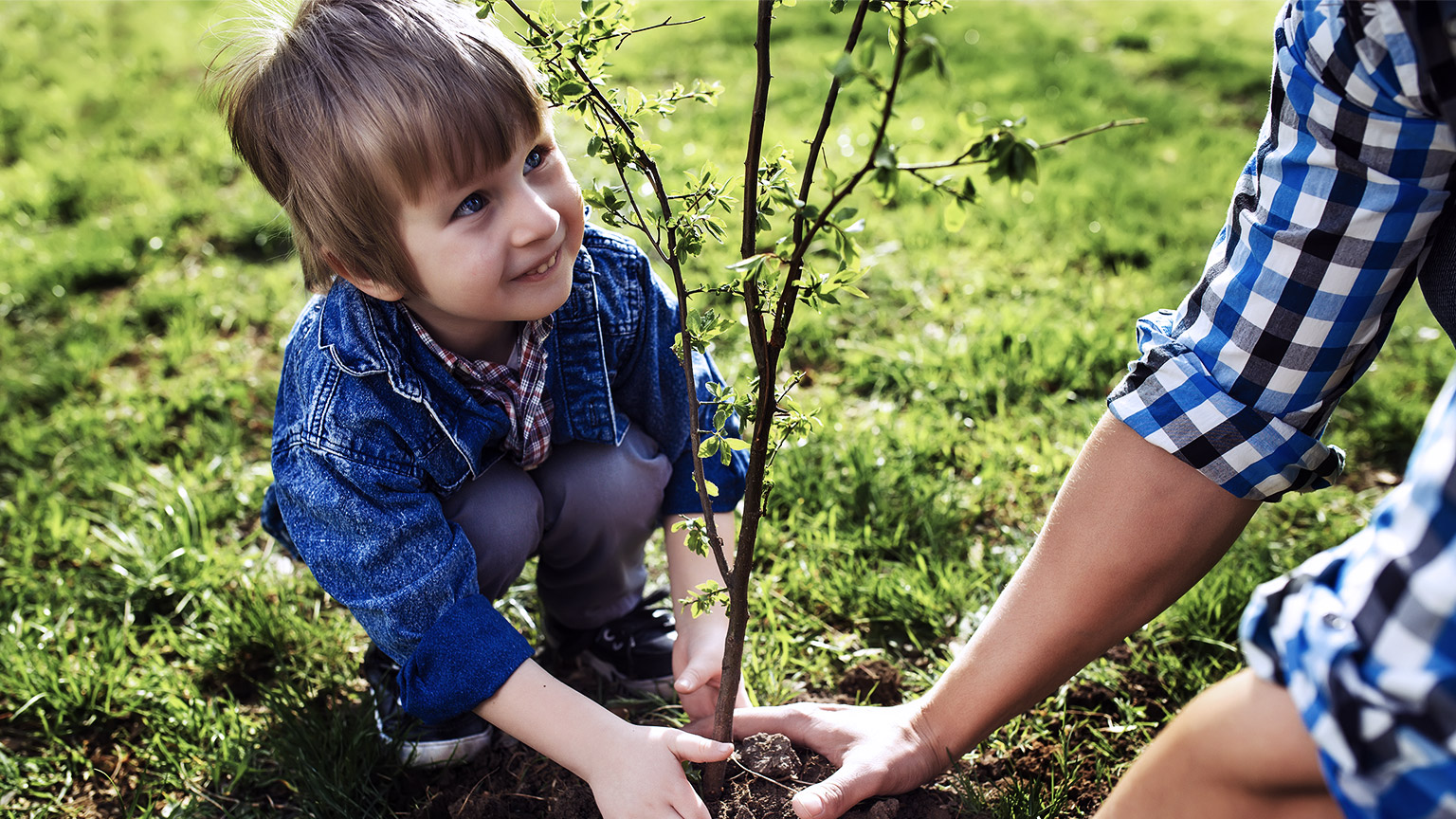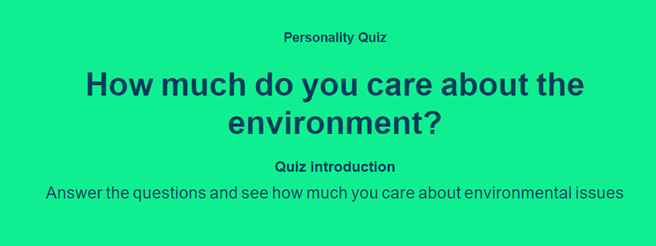This topic will guide you on how to implement teaching strategies and provide adequate natural play spaces to support children to develop an understanding and respect for the natural environment including the use of resources, natural materials and connections with community.
By the end of this topic, you will understand:
- role modelling respect and care for the environment
- how to set up adequate play spaces in the indoor and outdoor natural environments
- resources to enhance children’s respect and understanding of natural environments
- teaching practices that encourage respect and understanding of the natural environment
- connecting children to the natural environment through community interaction.
As an educator you are seen as the child’s first or second teacher.
As an educator you are seen as the child’s first or second teacher. This means that children will develop an attitude and view of the natural environment and how to care and treat it based on observing you and your interactions with the world. For this reason we must take our responsibility to role model appropriate care and respect for the natural environment in everything we do.
Understanding your own view
A great way to start developing a sense of being a role model is understanding your own view in relation to caring for the environment and natural spaces.
What do you consider in high regard? This could be caring for plants and animals or reducing use of energy and water.
Reflecting on your own views
Consider the following three (3) questions:
- What areas of the environment do you most care about?
- In your home and work practices how do you support the environment’s health?
- Why is it important to role model good practices to children?
Test yourself
Click on the following image to take this fun quiz to find out how much you really care about the environment.
Role modelling across environments
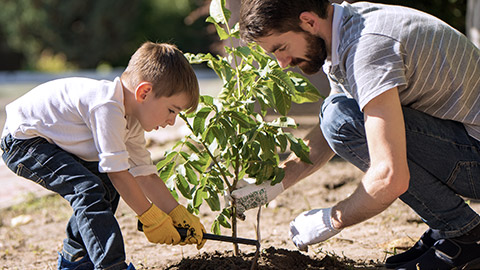
Once you understand your own views on caring and respecting the environment you then need to understand the views and philosophy of the service. It is important when role modelling practices to children that this reflects both your views as well as being in line with the service’s views.
Role modelling respect and care for the environment to children can be broken down into two (2) areas:
Constructed environment: This refers to an environment that has been built by a species. This includes either a human or another form of animal. Such environments can include:
- Your service
- Houses
- Buildings such as hospitals, shops etc.
- Bridges
- Parks and gardens
- Streets
|
Constructed Environment |
Role Modelling Practices |
|---|---|
|
Early childhood service |
|
|
Can you think of any other practices? |
|
Natural environments: This includes any environment that is living or nonliving that has not been developed or built by humans or other species and animals. It has occurred naturally.
Such environments can include:
- Mountains
- Valleys
- Rivers
- Forest
- Sand
- Water
- Rocks
- Plants
|
Natural Environment |
Role Modelling Practices |
|---|---|
|
Natural spaces in and out of the early childhood service |
|
|
Can you think of any other practices? |
|
Check your understanding
Along with establishing strong role modelling practise as an educator, we are also required to provide children access to play spaces and learning environments that provide opportunities for children to learn about caring and respecting the environment through contact with natural and recyclable resources.
Recycled materials include items made of:
- Wood
- Ceramic
- Paper
- Plastic
- Metal
As an educator we must ensure that the environment is set up to encourage the opportunity of connection with the natural environment. Connecting children with nature is not just about setting up one experience or sitting children down for a lesson. It also requires educators to embed natural materials into their play spaces and provide adequate access to natural environments. Opportunities to learn within nature should be at ease and seamless for children.
As an educator we also have a range of other holistic and varied learner requirements we need to implement for children such as physical development, self-help skills, language and cognitive development.
When we provide play spaces using natural and recyclable materials, we can use them specifically to promote learning and understanding of the environment as well as embedding them into other play spaces that promote other forms of learning.
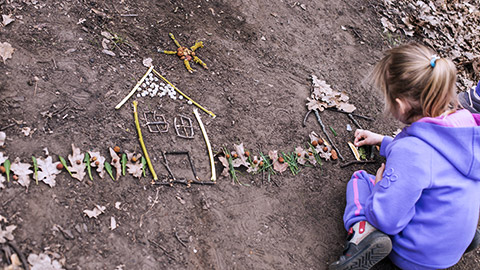
For example, using broken sticks, rocks and leaves as a way to set up an obstacle course rather than using specific equipment.
Nature play design
Different natural play designs encourage different types of play.
Watch
Watch the following 3-minute YouTube video below from ECA Learning Hub to learn more about different design ideas for natural play:
An open, relaxed environment
Contemporary theories and research informed by the Reggio Emilia approach recognise and value the environment as a ‘third teacher’. Behind educators and families, physical spaces hold the potential to influence what and how children learn.
Considering the environment in ways that are intentional and purposeful helps to:
- foster encounters, encourage communication and relationships
- create environments filled with natural light, order and wonder
- invite children to delve deeper, investigate and represent their learning through a range of mediums.
Sustainable environments promote the idea of children as partners and collaborators in their learning. These spaces have the potential to support children’s understanding of the environment, sustainable practices and their inherent responsibilities as global citizens.
Whatever the skills and abilities of the child and the type of education and care service, the environment should promote each child’s sense of agency. Physical spaces should allow children to be active contributors and have an influence in their world. This involves children contributing to make the environment safe, for example, using equipment and resources in an appropriate way.
Engaging environments
Learning environments engage and foster a sense of ownership and respect when they are aesthetically pleasing, reflect the identity and culture of children and families, and encourage a connection to place. As such, the physical environment is never simply a backdrop to the curriculum; it is an integral part of the curriculum or leisure based program. An environment with rich and built-in learning opportunities also frees educators to interact with children.
Some characteristics of engaging environments include:
- Interesting things: Natural materials and things of interest for children to see, touch and smell have an inherently higher degree of complexity in terms of patterning and versatility.
- Open-ended materials: Areas dedicated to different experiences such as art and craft, books and literacy, blocks and building materials, can help children’s engagement and learning. For example, a pine cone can be used as a prop for dramatic play or an item for construction. This is especially important when supporting a wide range of ages, abilities and learning styles.
- A balance of experiences: A balance of experiences facilitates shared thinking, including exploration, experimentation and hypothesising. Areas dedicated to experiences – for example, art and craft, books and literacy, blocks and building materials – can help children’s engagement and learning. The key here is for educators to be flexible about what experiences happen and where.
- Flexible access: Just as educators should embrace a flexible approach to experiences, they should also provide and encourage the flexible use and access to resources and equipment. This responds to children’s agency and interest in both indoor and outdoor spaces.
- Recycling and repurposing: Reusing, recycling, rethinking and repurposing of resources, furniture and equipment promotes an awareness of sustainable practices. This provides opportunities for children to problem solve and be creative in ways that develop their respect for the environment and thoughtful use of limited natural resources.
- The familiar and the novel: Balancing sameness and change, the familiar and the novel, responds to children’s need for both. Often small changes in the environment can be enough to ensure the environment is interesting and engaging, especially for very young children. Talking with children about possible changes and involving them in decision-making supports their agency, influence and learning and can reduce stress resulting from too much change.
Empowering and respectful environments
Respect for children as collaborators and partners with educators in their learning is central to the approved learning frameworks. Environments that are respectful of children’s emerging skills and competencies provide opportunities for them to make their own decisions and to act independently.
These environments:
- Encourage children to make choices, including whether to be with others or to be on their own. Arranging furniture to create areas can encourage children to disperse and be together by choice. Big open spaces that force children into large or small groups may interfere with these positive interactions.
- Support children to feel secure, and the equipment and furniture allows children to do things for themselves. Chairs that allow feet to touch the floor, sinks that are child height (or stable stools that allow children to safely reach the sink or get on the toilet themselves), tables and chairs that support backs while sitting, and lockers with hooks that are accessible all encourage children to exercise agency.
- Include displays of children’s work that are uncluttered and involve children in making decisions about whose work is displayed and how these are changed. It is important to acknowledge and honour the efforts of all children in meaningful and respectful ways. For example, working with children to identify work to be displayed may be more empowering than “wallpapering” with stencils or templated art work. • Create a vibrant and responsive space. Think about how much fixed equipment is necessary both indoors and outdoors, make changes as children’s needs and interests evolve and create a sense of discovery.
- Allow for children’s works in progress to be preserved over days or even weeks. 7
Further Reading
Read ACECQA’s information sheet about setting up environments as the ‘third teacher'.Early Childhood Australia produced a case study on two very different children’s services who had a shared commitment to creating high-quality physical environments for the benefit of the children in their care:
Case study
Read this case study and learn about how the Betty Spears Child Care Centre, established over 30 years ago, enhanced their outdoor space.
Watch
The following 16-minute video by ECA Learning Hub documents a service's development and implementation of a working Quality Improvement Plan (QIP) focused on aspects of Quality Area 3: Physical Environment. This process of developing and implementing the QIP will demonstrate the way in which improving the physical environment will impact on all seven quality areas of the National Quality Standard (NQS).
Note
You can find endless information about educating young children on the internet which can be useful for professional development or in conversations with families. It is always important to remember to check the credibility of the sources that you are wanting to access and refer to.
The general rule is that a credible source must be:
- government-based (such as ACECQA or the Department of Education), or
- qualified, such as:
- a professional organisation, such as KidSafe, Nature Play
- an education provider, such as Swinburne
- a professional magazine, such as Education Matters
Setting up a learning environment indoors:
Learning Environment
Natural Resources
Recycled Resources
Art area
Bark, leaves, flowers, rocks and sand
Cereal/snack cardboard boxes, phonebooks, magazines, mail, office paper, newspaper and cardboard
Construction
Stones, bark, branches and sand
Cereal/snack cardboard boxes, phonebooks, cardboard, jars, bottles and string
Home corner/dramatic play
Logs, pinecones and gumnuts
Buttons, curtain strings, cereal boxes, cardboard boxes, bottles and jars
Music and movement
Sticks, branches and shells
Tissue box, paper plates, string, toilet paper rolls, cardboard boxes and glasses
Here’s are some further examples of indoor play spaces using recycled and natural materials:Examples of indoor play spaces
To see examples of indoor play spaces using recycled and natural materials, see the following links:
Setting up a learning environment outdoors
All spaces outside have the benefit of having the natural environment around them. Educators should, however, consider how they use resources in the following spaces:
Outdoor play areas that draw children in to explore, experiment and build upon are those that usually have a mix of fixed spaces as well as lots of opportunities to access loose parts and open-ended materials that they can move around, rearrange and add to the spaces in different ways to extend upon their play.
The Empowered EducatorLearning Environment
Natural Resources
Recycled Resources
Running/bike track and climbing equipment
In this area educators should consider the scenery. Can the children see trees and plants? Can you use branches to make parking spots?
Tree trunks and log offcuts can be used as stepping-stones and climbing equipment.
Recycled materials can be used to make stop signs and traffic lights such as cardboard boxes
Used tyres can be used in obstacle courses.
Sand pit area
This area can be used for construction play and creative play. Children can add water, rocks and shells into their play
We can use recycled materials such as old pipes, jars, cooking utensils and recycled baking tins for play
Water play
Water play can be used to learn about measurements and eco systems. Use grass, rocks, shells and pinecones to add to the play
Buttons, bottles, tubes and containers
By exposing children to a range of natural play spaces and recyclable materials, we are providing children the opportunity to learn about the environment, how we engage and use the environment in our everyday lives and to have an overall respect and sense of responsibility to care and maintain it.
Overall, we want children to be exposed and engage with natural environments as much as possible. Consider the following image. As an educator, how can you ensure that children have access to all of these areas?
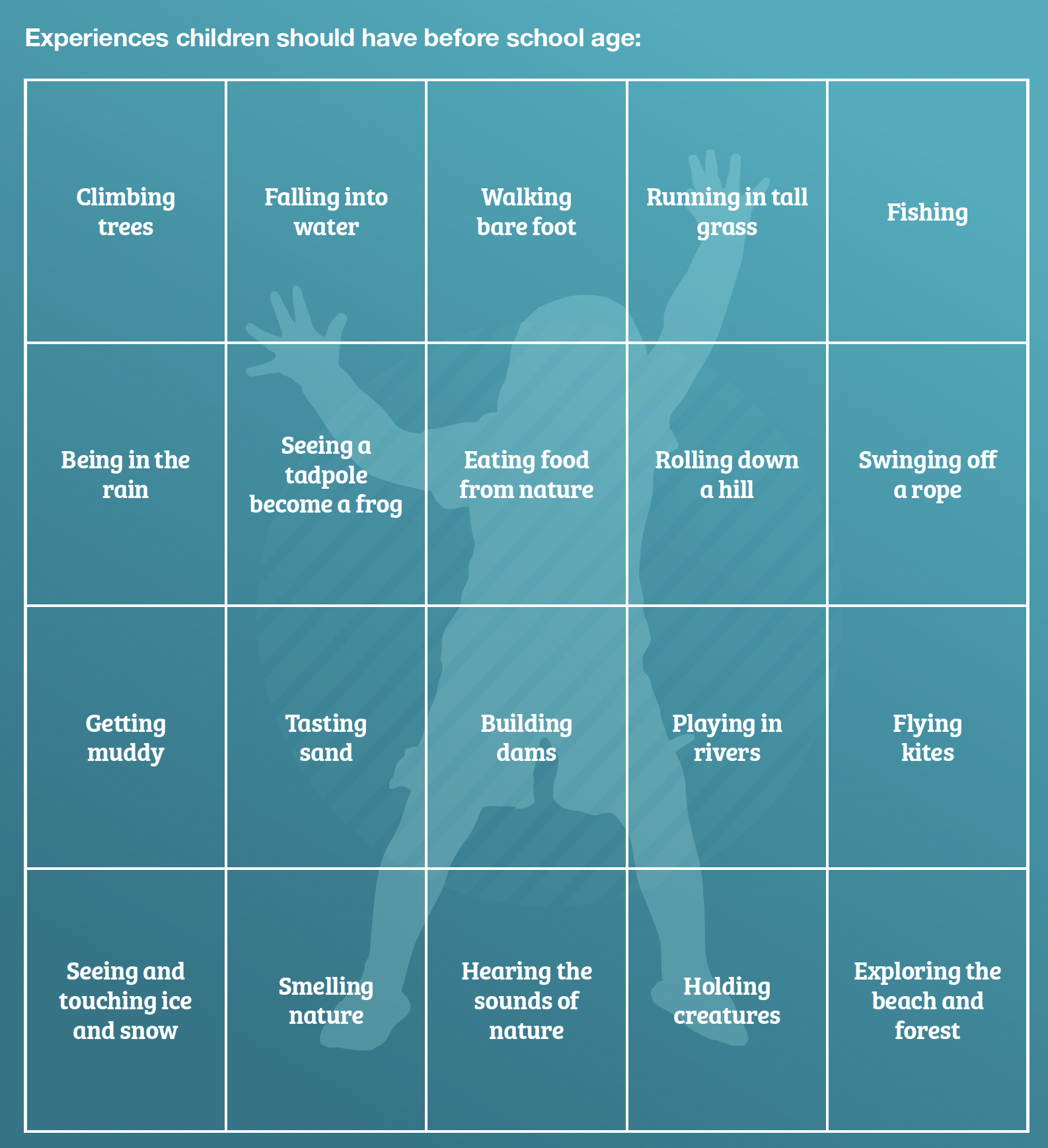
Watch
The following video series explores three (3) different Australian early years services, each with incredible natural outdoor environments with inspiring nature focused practices. These videos showcase how they embed their sustainable practices, explain the benefits, and show how they look in practice.
PART 1 :
PART 2 :
PART 3 :
Here are some examples of inspiring outdoor natural spaces:Note
Children develop an understanding of the interconnection of nature through their direct exploration of it and through planned activities.
Watch
Although the following 6-minute video was created by the Natural Learning Initiative, an American organisation founded to help communities creating stimulating places for play and outdoor learning:
Exposing children to natural spaces in the community
In teaching children respect and care for the environment it is important that our teachings continue outside of our service environment. Connecting children with their local community and the natural environments within, it allows children to understand the larger impact that caring for and respecting the environment has in our world, the world of people we know and the world in which our community and country lives.
As best practice, services will embed entering the community and exploring the space. This might be weekly, every fortnight or monthly. As part of the curriculum, the service should also include incursion and excursion to other constructed and natural environments.
Embedded community outings might include exploring the:
- Local park or natural spaces
- Op shop
- Fresh fruit and veggie store
- Bush kinder
- Indigenous sites
- Nature walk
- Library
- Toy library
Bush kinders
Bush kinders are becoming increasingly popular in Australia. They are usually located in natural environments away from an education or care service's building.
Further Reading
From The Spoke 'Bush kinder program', read more about how bush kinders are being used by different services.
Watch
The following 4-minute video published by the Department for Education, Children and Young People, Tasmania, gives an example and explains the benefits of bush kinder:
Through outdoor play, children may also develop an understanding of the bush in a culturally responsive way by learning alongside Aboriginal people.
Watch
The following 3-minute video published by the Department for Education, Children and Young People, Tasmania, showcases a Bush Kinder program through the Sustainability Learning Centre which is a joint venture between Aboriginal Education Services and the Sustainability Learning Centre:
When you are conducting an outing into the community with children, you need to make sure that you have a purpose and goal. As an educator, you need to develop a lesson plan to devise what you want the children to learn from engaging in the natural or constructed environment that you have chosen.
You need to consider:
- What would I like the children to learn?
- How will I engage the children during the outing to reinforce the learning?
- How will I assess the learning after the outing?
- How will this learning impact their ability to understand, care and protect the environment?
This information sheet explores in-nature programs, the benefits of these programs and the practical things which need to be considered when planning and implementing in-nature programs.
Watch
The following 11-minute video showcases Denmark’s forest kindergartens who are one of the country’s leading the way in programs based in natural outdoor environments. It provides a unique insight into their focus on in-nature programs and how it benefits children’s learning.
Check your understanding
Setting up the learning environment and play spaces to expose children to the natural environment is vital for them learning and caring for the environment today and into the future. It is also important that we embed other resources for children to engage with within the curriculum to allow for them to extend their knowledge and learning about out natural environments and the impacts human behaviour has on them.
Such resources can include:
- Songs
- Story books
- Posters and images
- Appropriate media such as video clips
- Resource kits (these may cover concepts such as weather or the life cycle of a plant)
- Puzzles
- Games
Find below some examples of suitable stories for children:
Watch
WINDOW, by Jeannie Baker
An illustrated story that follows the life of a boy, born in a house in the Australian bush but privy to its development from a wooded haven to a bustling city.
You can also watch and listen to the story below.
THE RABBITS, by John Marsden & Shaun Tan
A story to better understand Australia’s history and the destruction of the environments that Indigenous Australians call home.
You can also watch and listen to the story below:
MAGIC BEACH, by Alison Lester
A story of Australian summers and the value of frolicking in the waves and imagining the whole world along the sands of the beach.
You can also watch and listen to the story below:
GRETA AND THE GIANTS, by Zoe Tucker
A story inspired by Greta Thunberg which tells the tale of how humans (the giants) cutting down forests are destroying animal’s homes. Greta then stands up and inspires to giants to begin to care for the forest and return it to its former glory.
You can also watch and listen to the story below:
Check your understanding
How can a puzzle assist children in understanding the impact that humans have on the environment?
It is valuable that educators have the correct learning environment and resources to connect and teach children about the natural and constructed environment.
However, the most important aspect of learning and developing for children is to have well-thought-out and intentional teaching practices that allow children to connect what they are seeing and doing to knowledge and skill.
This requires educators to do the following competently:
- Plan experiences and activities and engage the children in inquiry-based learning during these experiences
- Observe and be aware of spontaneous play learning opportunities, and when they arise, engage with children and use intentional teaching to make meaning of the experience
- Use routines as an opportunity to teach children
General teaching strategies
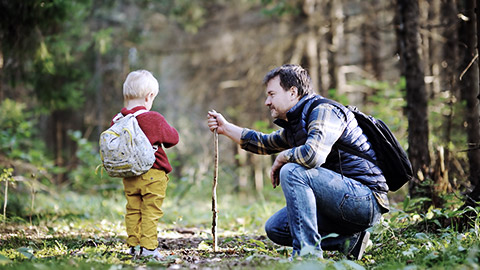
When engaging children in learning about the natural environment, educators should use the following strategies
- Research the environmental concept
- Role model acceptable practices
- Set up a suitable environment
- Demonstrate and teach new skills and practices to care for the environment
- Ask children open-ended questions
- Be responsive to children’s questions
- Observe children’s emerging interest in the environment and plan for them
- Follow-up on children’s ideas and ‘why’ questions. Research these if needed, such as where does the water from the toilet go?
Engaging with the natural environment: things to do with infants and toddlers (children aged 0-3):
- Bake mud pies in a home-made mud bakery
- Have an outdoor picnic
- Lie under a tree and look up at the sky through the leaves
- Lie on your tummy and look and play with grass and mud
- Create a nature treasure basket to explore with a stick, rock or feather
- Make music with a seed pod shaker
- Throw a ball
- Mud paint with your fingers on the ground
- Follow a bug on its journey
- Dig in the sand or dirt to hunt for 'dinosaur’ bones
- Water paint on rocks or the ground
- Stack large flat pebbles
- Talk about what you see, hear and feel outside
Engaging with the natural environment: things to do with children aged 3-5 (also called preschoolers or kinders, depending on the state/territory):
- Collect natural objects and build a magical fairy garden
- Create your own musical instrument using natural things and form a 'bush band' with other children joining in
- Make a stick person out of sticks
- Find a rock and paint it with water colour paints or chalk
- Build a natural obstacle course and have a fun race
- Use a stick pencil to write your name in mud
- Recreate a favourite story outside
- Draw around shadows at different times of the day
- Create an imaginary campfire with sticks and sing songs around it
- Build a little motel for bugs and insects
- Plant a seed, water it and watch it grow
- Paint with nature paint brushes you find (like a leave, twig or cone)
- Go on a nature scavenger hunt.
Note
Children develop an understanding of the interconnection of nature through their direct exploration of it and through planned activities and routines.
Play
Play includes all the self-directed ways children can be encouraged to explore the natural world both inside and outside through self-directed curiosity. Play can include time in a sandbox, on a playground, in a park or using pinecones as money in the home corner. Play can also include an indoor water activity, time with an animal or simply playing with safe, natural objects.
It is important that educators set up the inside and outdoor environment in a way that allows children to freely engage with nature play.
When setting up the environment for nature play, educators should consider:
- Does every play space have the element of natural resources?
- Are the natural resources accessible for the children?
- Do the resources range in texture, smell and size?
- Are the outdoor spaces open and available for children to use, such as climbing a tree?
- Are the resources being used in their natural form? For example, children are collecting leaves for painting from the floor rather than picking them off the tree?
Activities
Activities include planned exercises to explore nature such as a story, creating a fort or naming the shapes of clouds outside. These planned activities may be led by the educator but should allow an exploratory element for teaching to explore their own ideas and concepts within nature.
Watch
Watch the following 6-minute YouTube video by Fairfax Futures for simple exercises and tips on how to help children explore the natural environment. Also listen for the parent explaining how this has impacted their relationship with their child:
Case study
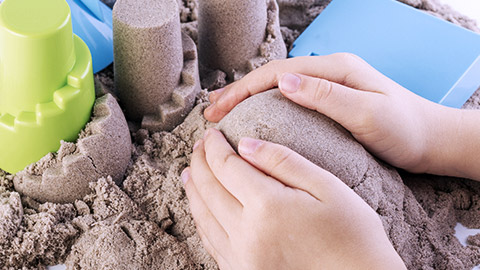
Read the following scenario and think of possible outcomes for learning within the nature play experience:
Educator Max has set up a sand and water play activity for the four-year-old kindergarten group. Max has placed a recycled PVC pipe on an incline leading to the edge of a sandpit. His idea is that the children will pour water into the top of the pipe and then watch it come out the bottom and into the sandpit. The children are excited, and two boys are quickly building a sandcastle under the opening of the pipe. The boys hope to prove that the castle they build will be so big and strong that the water cannot possibly destroy it.
- science and mathematical concepts e.g. pouring and filling, weight and volume
- problem-solving e.g. how can we stop the sand being absorbed by the water?
- spatial awareness e.g. understanding the relationship of objects
- social skills e.g. sharing equipment, taking turns, sharing space with others, working as part of a team
- motor development e.g. digging, scooping, pounding spreading
- eye-hand coordination e.g. reaching and grasping
- language development e.g. asking questions, listening to others, engaging in conversation.
STEM
STEM is an approach to learning and development that integrates the areas of science, technology, engineering and mathematics. Through STEM, students develop key skills including: problem solving. creativity.
Inquiry-based STEM education in the early years is a collaborative process, which encourages children to raise questions and explore their interests. In a playful way, children are familiarised with scientific processes and learn to think scientifically. Early STEM education does not teach facts but kindles children’s inquisitive minds.
In progressive early STEM education, the adult takes the role of the facilitator, empowering children to shape their own learning, and establishing a collaborative environment. The adult observes children’s individual interests, involves them in decision-making and provides prompts to stimulate their thought processes.
Case study

Four-year old Sam watches you put ice cubes in a glass of water on a hot day. She sees the ice cubes melt in the water and is fascinated by the process. She asks you if she could add more ice cubes to the glass.
This is a great opportunity for you to kindle her interest by saying something like ‘I wonder how long it would take for all this ice to melt.’ Or you could say ‘I would love to find out how we could prevent the ice cubes from melting so fast.’ This could be a starting point for research or provoke further questions. Sam might begin her own investigations by taking the glass with ice cubes outside to melt them in the sun.
STEM learning does not require expert knowledge, nor do you need a recipe book or a science kit. Listen to your children’s questions and let your own curiosity and inquisitiveness do the rest.9
Watch
Watch the following almost 5-minute video to better understand how science, technology, engineering, and math (STEM) experiences can be incorporated in the early childhood classrooms:
Here are some more examples of STEM activities for children to explore their natural and constructed environment:
| Areas of STEM | Examples |
|---|---|
| Science |
|
| Technology |
|
| Engineering |
|
| Maths |
|
Routines
Routines include bringing an understanding of the natural world into regular habits such as mealtime (talking about where the food came from or how it grows) or tidy up time (talking about how to take care of our surroundings). This can also include transitioning some of the services routines to be outside in nature, such as lunch time outside, going for a picnic for afternoon tea or, on a nice day, having a sleep or quiet time outside.
Note
Create a daily song routine to help children notice the weather, similar to the following video.
Watch
Watch the following 2-minute YouTube video by The Kiboomers - Kids Music Channel as an example of a weather-song for group times:
Specific content teaching
In connecting children to the natural environment, it is important to take the opportunity to ensure that we are advocates for teaching the children about:
- Interdependence between people, animals and the land
- The connection that Aboriginal and Torres Strait Islander Peoples have with the land
It is important for educators to ensure that children get the opportunity to learn and understand the interdependence between people, animals and land. This allows children to understand the importance of each in our world and to develop an understanding and strategies on how we can look after and care for our immediate world.
This includes teaching children about:
- The purpose of trees and oxygen
- Growth of fruit and vegetables
- Eco systems providing homes for species
- Using animals for food and drink
- Animals providing manure for plant growth
- Interdependence of insects and plants
Ideas for teaching interdependence
- Plant a vegetable or herb garden (herbs are easy to grow even in smaller indoor pots). Help the children tend and care for the growing plants. Teach them how to harvest them and then include them in a meal
- Build a small chicken coup and teach the children to help care for the chickens and collect the eggs. Use the eggs in a meal or share them with their families
- Build a worm garden. Old fish tanks make a wonderful, visible way for children to watch worms move through soil. You can also build a worm compost for kitchen vegetable waste
- Build a simple enclosure for butterfly friendly plants. Purchase cocoons and place them in the enclosure. Let the children watch them turn into butterflies. Set the butterflies free.
It is important that educators are advocates for looking after insects and plants. This shows respect to the work they do and the interdependence we have on insects and plants and that they have on each other. To show respect for these environments, you should:
- Ensure that plants are not stood on or have leaves picked off them
- Ensure that insects are not collected or moved out of their natural environment
- Ensure that insects are not harmed or hurt
- Ensure that children are taught safety practices in living peacefully with insects such as ants and spiders
Watch
Watch the following 4-minute YouTube video by ARTLKING about the relationship between insects and plants:
Respecting animal friends
Teaching children to understand and care about animals and pets is vital to them developing empathy, understanding and responsibility. It also supports children’s social development as this becomes a shared responsibly. It is the first stage of a child’s learning to take care of another living thing. Many services are undertaking pets at the service that become the children’s responsibility to look after.
Having pets and animals in services supports children to appreciate the interdependence of people and animals and the life cycle that we are all a part of.
The animal is a conduit for learning to be human: some propose that it is only through the animal that we recognise our humanityJill Bone (2013)

Animals that make suitable pets at a service are:
- Chickens
- Birds
- Fish
- Guinea pigs
- Rabbits
- Dogs
- Lizards, frogs and turtles
- Stick insects
Responsibilities that children can take on include:
- Feeding the animal
- Cleaning the animal cage
- Ensuring adequate heat
- Maintaining the pets physical activity needs
- Providing a calm and gentle environment for the service
Class pet
Adopt a class pet. Consider the needs of the children, allergies and the ability of the parent community to be responsible for caring for the pet during holidays. This can also include hosting worms in a glass container or sponsoring an animal through the World Wildlife Fund or a local organization and displaying a picture with updates on the sponsored animal.
Watch
Watch the following 2-minute YouTube video about animals’ habitats. The video can be introduced and discussed at group time toprompt conversations about the different animas and how to care for them:
Further Reading
The Australian Children's Education and Care Quality Authority (ACECQA) have developed an information sheet on keeping pets and animals in education and care services.
Read the information sheet to learn about the benefits of having a pet, explore how to select a pet that's right for your service and how to assess and manage the risks of having a pet.
The benefits of pets and children
Watch the following less than 2-minute YouTube video by PetSmart to learn more about the benefits of small pets for children:
Aboriginal and Torres Strait Islander Peoples' connection to the land
Many organizations, including educational and childhood service centres, now make an effort to acknowledge the Aboriginal history and original ownership of the land on which they reside. This practice is a way of paying respect to elder’s past, present and emerging and helps to acknowledge the important roles that Aboriginal and Torres Strait Islander people play within local communities.
We acknowledge the Traditional Owners of the land on which we meet today. I would also like to pay my respects to Elders past and present.
Aboriginal and Torres Strait Islander people are connected with land and waters and see it as part of who they are. This is different than non-indigenous people who often undervalue the land or nature. This connection to the environment comes from their belief that the land and people were created by ancestor (spirit) beings who continue to protect and care for the land. The land refers to everything within the landscape, including water, air, trees, rocks, plants, animals, and landforms. These are all intertwined and essential to their well-being, so Indigenous peoples consider the land to be a part of them. Therefore, they have a responsibility to look after their environment and to use natural resources wisely. Aboriginal and Torres Strait Islander people consider it their role to take care of the land such as burning off and re-planting.
The Aboriginal and Torres Strait Islander cultures have survived for thousands of years. That is, in part, because of their knowledge and protection of their Country. Each language group or clan has a defined area of land, or Country, to which they are connected or belong. They know where to find sources of water and the effects of seasons on plants and animals. They also know how to use and conserve natural resources that provide food, medicine, shelter, and tools. 10
One of the eight (8) principles of the EYLF mandates services to embed Aboriginal and Torres Strait Islander
Perspectives as this is a key tool to advance Reconciliation and it also contributes to Closing the Gap commitments and fulfilling every Australian child’s right to know about Australia’s First Nations’ histories, knowledge systems, cultures and languages. Embedding Aboriginal and Torres Strait Islander perspectives is a shared responsibility of approved providers, educators, and other professionals working in early childhood educational settings, regardless of whether Aboriginal and Torres Strait Islander children and families are enrolled in that setting.11
Do you know the Aboriginal history of the land your service resides on?
The Australian Institute of Aboriginal and Torres Strait Island Studies (AIATSIS) has created a map of Aboriginal Australia.
Click on the image below to view the map and use it to find out the cultural history of the land your service resides on:
As part of teaching children to connect with the community we also need to ensure that we teach children about Aboriginal and Torres Strait Islander peoples connection to the land.
For Aboriginal and Torres Strait Islander peoples, land is not seen as a monetary asset. They do not view the land as something that belongs to us, but more importantly, we belong to the land. When we pass, we go to the land and therefore it carries our ancestors and culture. There is a strong spiritual connection to the land.
Watch
Watch the following 6-minute YouTube video where aYankunytjatjara elder and traditional owner of Uluru (Ayer's Rock) explains how the connectedness of every living thing to every other living thing is not just an idea but a way of living.
Educators are required to implement experiences and opportunities for children to learn about Aboriginal and Torres Strait Islander peoples' connection to land and how they use the natural environment.
This can be done through the following practices:
- Intentionally planned experiences focused on using Aboriginal and Torres Strait Islander peoples' practices
- Incursions and excursions connecting with Aboriginal and Torres Strait Islander peoples
- Yarning circle
- Acknowledgement of land every morning
Research experiences that can be included in the curriculum to ensure the teaching of Aboriginal and Torres Strait Islander peoples' connection to land and nature are listed here.
Note
Caring for and tending to nature is an important part of Aboriginal and Torres Strait Island cultures. Nature play is an opportunity for all children to learn to recognise and appreciate this living history.
Use the following questions to check your knowledge.You can check the correct answer by clicking on the 'Answer' button:
Q1. In your own words, explain what the difference is between the natural and constructed environment.
Constructed environment – This refers to an environment that has been built by a species. This includes either a human or another form of animal.
The natural environment is all around us, whether we live in a crowded city or a rural town with lots of fields and rivers. It refers to all living and nonliving things and excludes things that are artificial. In early childhood services the natural environment can often be seen as the outdoor space and the community space services used for excursions.
Q2. What are three ways that you can role model care for the environment to children?
- Using resources properly and packing them away when finished
- Keeping the environment clean
- Allowing fresh and natural air by opening doors and windows
- Turning lights off when not in the room
- Recycling water where possible
- Using a clothesline instead of a dryer
- Recycling materials
- Using both sides of note paper
- Putting rubbish in the bin
Q3. 'Connecting children with nature is not about setting up one experience or sitting children down for a lesson. It requires educators to embed natural materials into their play spaces and provide adequate access to natural environments.’ Reflect on this statement. What are some strategies you may use to ensure that you implement this correctly?
- Engaging with children in play and asking intentional question
- Planning excursions and incursions for children to access natural environment
Q4. How can you use play, activities and routines to encourage connection to the natural world?
Play, activities and routine can be used to connect children to their environment by making sure all play spaces and activities are using a variety of natural resources and are set in natural environments. We can use routines by giving children responsibility to implement routines in a sustainable way to care for the environment. such as tipping the drink bottle water into a plant.
Q5. List three (3) ways to engage children 0-3 with the natural world.
Engaging with the natural environment: things to do with infants and toddlers (age 0-3):
- Bake mud pies in a home-made mud bakery.
- Have an outdoor picnic.
- Lie under a tree and look up at the sky through the leaves.
- Lie on your tummy and look and play with grass and mud.
- Create a nature treasure basket to explore with a stick, rock or feather.
- Make music with a seed pod shaker.
- Throw a ball.
- Mud paint with your fingers on the ground.
- Follow a bug on its journey.
- Dig in the sand or dirt to hunt for 'dinosaur' bones.
Q6. List three (3) ways to engage children 3-5 with the natural world.
- Collect natural objects and build a magical fairy garden
- Create your own musical instrument using natural things and form a 'bush band' with other children joining in
- Make a stick person out of sticks
- Find a rock and paint it with water colour paints or chalk
- Build a natural obstacle course and have a fun race
- Use a stick pencil to write your name in mud
- Recreate a favourite story outside
- Draw around shadows at different times of the day
- Create an imaginary campfire with sticks and sing songs around it
- Build a little motel for bugs and insects
- Plant a seed, water it and watch it grow
- Paint with nature paint brushes you find (like a leave, twig or cone)
- Go on a nature scavenger hunt.
